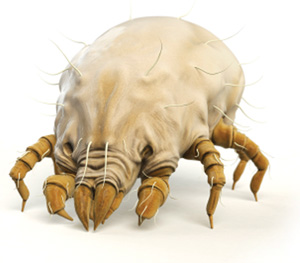Resources
-
Consejos Para Evitar Los Alérgenos - Tips for Allergy Relief
Los médicos especialistas en alergias y asma nos cuentan que las principales alergias son al polvo, los ácaros del polvo, las esporas de moho, el polen y la caspa de los animales. Todos estos alérgenos tienen dos cosas en común: son partículas minúsculas que flotan en el aire y mayormente se tienen que inhalar para causar síntomas de alergia. Un error común entre las personas que sufren de alergias es suponer que si uno no puede evitar todos los alérgenos todo el tiempo, no tiene sentido tratar de evitar ninguno de ellos. Sin embargo, según algunos médicos alergistas, inhalar los alérgenos del aire es un problema acumulativo. Si uno es alérgico a una o varias sustancias, lograr evitar aunque sea solo una de ellas puede mantener sus alergias bajo control. De hecho, con medidas de prevención continuas y minuciosas, junto con las demás recomendaciones y el plan de tratamiento de alergias de su doctor, usted puede lograr un estilo de vida más sano. PROTECTORES DE CAMA PARA LAS ALERGIAS A LOS ÁCAROS DEL POLVO Los ácaros del polvo son bichos parecidos a las arañas que son demasiado pequeños para ser vistos por el ojo humano. Tanto los cuerpos como las heces de estos ácaros se consideran alérgenos. Estos se encuentren en los colchones, las almohadas, los cobertores de cama, los juguetes de peluche, las alfombras, los muebles tapizados, la ropa, la tela, e incluso en artículos fabricados con materiales “hipoalergénicos”. Antes las personas se resistían a usar protectores porque estaban hechos de materiales
Los ácaros del polvo son bichos parecidos a las arañas que son demasiado pequeños para ser vistos por el ojo humano. Tanto los cuerpos como las heces de estos ácaros se consideran alérgenos. Estos se encuentren en los colchones, las almohadas, los cobertores de cama, los juguetes de peluche, las alfombras, los muebles tapizados, la ropa, la tela, e incluso en artículos fabricados con materiales “hipoalergénicos”. Antes las personas se resistían a usar protectores porque estaban hechos de materiales  vinílicos o plásticos. Pero ahora hay protectores de telas más suaves y duraderas. Algunos de los protectores antiácaros más avanzados, como los productos de la marca BedCare™, utilizan una barrera de tela de tejido cerrado que funciona como un filtro para protegerlo/a de este potente alérgeno. Continue reading →
vinílicos o plásticos. Pero ahora hay protectores de telas más suaves y duraderas. Algunos de los protectores antiácaros más avanzados, como los productos de la marca BedCare™, utilizan una barrera de tela de tejido cerrado que funciona como un filtro para protegerlo/a de este potente alérgeno. Continue reading → -
Allergy Resource Center
The allergy prevention community is robust. It is always working towards finding the latest products, prevention tips and information to help allergy sufferers lessen their symptoms. Education is one of the biggest battles. Learning all you can about what causes allergies and how to control and lessen allergy triggers is a big step towards finding relief. Continue reading → -
6 Steps to Allergy Control at Home
Take Action to Control Your Allergies This set of guidelines, developed in accordance with the National Institutes of Health (NIH), Asthma Prevention Program, will help you to reduce allergen exposure in your home. The first place to start is in the bedroom. Continue reading → -
Reducing Allergens in Your Home
The First Step Controlling Allergens in the Bedroom It is most important to focus on the bedroom first, since the bedroom is where you spend up to one-third of your day, and it is also where you come into contact with the biggest allergen source — your bed! What should be a clean and restful place is packed with up to 1 million dust mites that produce the allergens that cause your symptoms. Physicians recommend covering your bed in allergy encasings to find relief. Continue reading → -
Understanding Allergies
The Basic Facts on Allergens: Allergies can bring about sneezing, congestion, watery eyes, wheezing and other tell-tale symptoms. If your physician has diagnosed you with allergies, you may be wondering what causes them or what the best steps are to decrease symptoms? Learning about allergies will help you understand the steps to take as you follow your physician’s advice for treatment. To get you started, here are some allergy basics. Continue reading → -
Understanding Dust Mite Allergy
The Basic Facts on Dust Mites: Dust mites are eight-legged arachnids, and are relatives to spiders and ticks. Dust mites are microscopic and, unlike bed bugs, cannot be seen by the naked eye. Adult dust mites live for 2-to-3 months. During this time a female dust mite can lay 25 to 50 eggs every 3 weeks. Large dust mite populations can result, with up to 1 million dust mites inhabiting a single bed! Continue reading → -
Understanding Pet Allergies
The Basic Facts on Pet Allergens: Many people are allergic to animals and may think that the allergy is caused by the pet hair itself. Pet allergen isn’t actually the hair, but is instead a protein present in the animal dander. The dander is made up of flaky skin cells and dried saliva, and it causes allergic reactions ranging from inflammation in the nose and eyes to asthma attacks. Continue reading → -
Understanding Mold Allergies
The Basic Facts on Mold: Molds are microscopic fungi and are made up of clusters of filaments that live on plant or animal matter, which they decompose for nourishment. Many molds reproduce by releasing spores into the air, which settle onto other organic matter and grow into new mold clusters. Mold can be found wherever there is moisture, oxygen and something organic to feed on. Since molds need moisture or water to survive, the key to combating mold is to control moisture by keeping areas dry and humidity low. Continue reading → -
Allergy 101
When it comes to learning about allergy relief, the experts at Allergy Control Products know how to point you in the right direction for improving life indoors. Allergy Control Products has been helping allergy sufferers since 1983, which means that for over 30 years, we’ve been the most physician-recommended company for allergy education and effective allergy products. We’ve outlined here the top Allergy Relief Tips to help you lead a healthy, allergy-free life. Continue reading → -
Allergy Information
Looking for Allergy Information for Allergy Relief? The Allergy Control Products website is full of helpful allergy information regarding the best path toward allergy relief. We’ve provided focused allergy tips that can help reduce allergens around your home. By following just a few simple steps, you can make a lasting difference in your health and quality of life. Continue reading →
